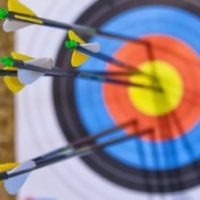Anybody involved in archery knows that modern compound bows nowadays come with many different cam systems. Though more complex designs do exist, the most common are single cam and dual cam bows.
If you’re trying to decide on what compound bow to buy you’ll probably face the question of which cam style is better for you. In this post, I’ll try to help you understand the differences and make a decision – single or twin cam bow.
Both single and dual cam bows have their pros and cons. Single cam compound bows need less tuning, are quieter, and are more precise. Twin cam bows shoot much faster arrows and have a more solid back wall. It’s a matter of preference and skill level.
Besides the cam system, there are a lot of things to consider when trying to decide on a compound bow. I’ve made things easy for you in my compound bow buyer’s guide. I’ve also listed my top compound bow recommendations there. In this post, we’ll dive deep specifically on the topic of cam systems.
So before we begin comparing single vs dual cam bows, let’s rewind and explain the basics – what are the differences between them?
What is Single cam vs Dual cam compound bow?
Modern compound bows have an intelligently designed system that stores a lot of the energy in the cables and the limbs. This translates to less work on the archer’s part when pulling and holding the bow. An essential part of that is the cam system.
The cam is basically a small wheel that is mounted on the top or bottom limb. As their names suggest, single cam bows have one cam, and dual cam bows have two. A Solocam bow has one power cam and one idler wheel, typically on the bottom, while a twin-cam bow has two symmetrical wheels.
With a recurve or traditional bow, that doesn’t have cams, holding the bow at full draw is hard. You have to continuously pull the full weight of the bow. The cams on a compound bow are designed to lower the weight at full draw. The maximal weight of the bow is reached at the beginning of the draw, and reduced weight is held at full draw.
I actually found a really helpful video that explains the difference between bow cam types. I recommend watching it if you want to learn more.
In the past archers were using hard vs soft cams. Soft cams accelerated the arrow more gradually, but hard cams were typically faster. Nowadays you’ll have a hard time finding a soft cam bow. Any cam system that shoots arrows above 290 fps (feet per second) will be considered a hard cam – and that’s almost all compound bows in the market today.
Twin and single cam compound bows have different pros and cons, which have to be kept in mind if you’re considering which type of bow to get. Let’s discuss them.
Comparing single and dual cam systems
Choosing a cam system that fits your needs is not a trivial task. To do that, you’ll need to understand the differences in the performance of dual and solo cam compound bows. To make things easy and understandable, I’ve organized the criteria in a comprehendible table:
| Criteria | Single cam | Dual cam |
| Speed | Slower | Faster |
| Noise | Quieter | Noisier |
| Accuracy | More accurate | Less accurate |
| Maintenance | Easy and less frequent | Harder and more frequent |
| Back wall | Less solid | More solid |
Most archers nowadays use a solocam bow. The pros and cons of both single and Twin cams become less and less significant as technology makes both better.
Single cam
Solocam bows are more reliable and go out of tune less frequently. They are considered to be more accurate and quieter but typically shoot slower arrows. Most compound archers these days are using a single cam bow.
Since single cam bows only have one wheel, they are less demanding when considering maintenance. The big issue with dual cam bows, cam synchronization, does not exist in solocam bows. So they require less frequent tuning, and the tuning itself is typically easier and cheaper. Even when out of tune, one cam bows are affected less by tuning issues.
Because they are typically not affected by tuning issues, single cam bows are considered to be more precise. The path of the arrow doesn’t suffer from aiming issues, so the bow is more accurate.
Another advantage of solocam bows is that they’re much quieter than dual cam. This is really important for bowhunters, that may alert and scare their target away with any small noise.
Dual cam
Twin cam bows are great for archers who need a more aggressive draw. They have two wheels storing energy for a faster arrow. They also typically have a more solid wall than single cam bows, which is really comfortable for maintaining good archery form.
Since they have two cams instead of one, in a symmetric build, the dual cam bow shoots faster arrows and in a straiter path. Less energy is wasted on this design, and two wheels allow more energy to be stored and released when the arrow is shot.
This means that less effort is required on the archer’s part for the same amount of energy to be put into the arrow’s travel. This, of course, results in faster arrows. Of course, arrow speed depends on a lot of other things as well, like brace height and draw weight. You can learn more about brace height in my previous post, and about draw weight in another post.
They also have a more solid back wall, which is really comfortable for avoiding over-draw. The back wall is basically the point where the archer feels they can’t pull anymore because they’re at full draw. A more solid wall means it’s easier to tell when you should stop pulling, which translates to better archery form.
What about other cam systems?
Besides single and dual cam systems, there are a lot of mixed and more complex models that should be discussed as well. They are obviously less common than the standard models but have interesting advantages.
- Hybrid cam: these are a complex version of dual cam compound bows. They have 2 cam systems, but instead of identical and symmetrical wheels, they typically have a control cam on the top of the bow and a power cam at the bottom. This asymmetry allows them to have the benefits of being quiet and powerful with less need for maintenance (but still require some level of tuning). They are a good middle ground between solocam and twin cam bows but are still a less common design.
- Binary cam: the technical design of the binary cam bows take the dual cam but removes the synchronization issues that come with it. By having two symmetrical cams slaved to each other by dedicated cam-to-cam cables, they remove the need for timing. They are considered to be noisier than twin cams though. Note that binary cam compound bows are more common outside of North America.
These complex models are harder to find in the market, but their intelligent design gives them a lot of pros. Consider that when purchasing
Conclusions
Deciding what type of compound bow fits your needs isn’t a difficult task when you understand the differences between them. Single cam bows are the most common type at the moment and are considered to be quite accurate. Dual cam bows shoot faster arrows and have a more solid back wall.
If you’re wondering whether to get a compound bow at all or go for a recurve bow instead, I have a detailed guide that compares the two, with all the information beginners need. Give it a read!
I hope this short guide helped you out with understanding the differences and comparing them.
The Best Compound Bows I’ve Reviewed
Genesis Genx
A great budget option for beginner archers, who are looking for a great first bow at a reasonable price. This bow is perfect as an entry bow you can progress with, since you can adjust the draw weight between 25 lbs and 40 lbs, and the draw length between 21″ and 30″.
Like most other things, you can find it in Amazon.
Diamond Infinite Edge Pro
This is my absolute favorite recommendation to beginners, who are looking for a bow to start and progress with. This highly adjustable compound bow comes with an insane draw weight range of 5 pounds to 70 pounds, and draw length of 13″ to 31″.
You can also read more in the full compound bow buyer’s guide.





